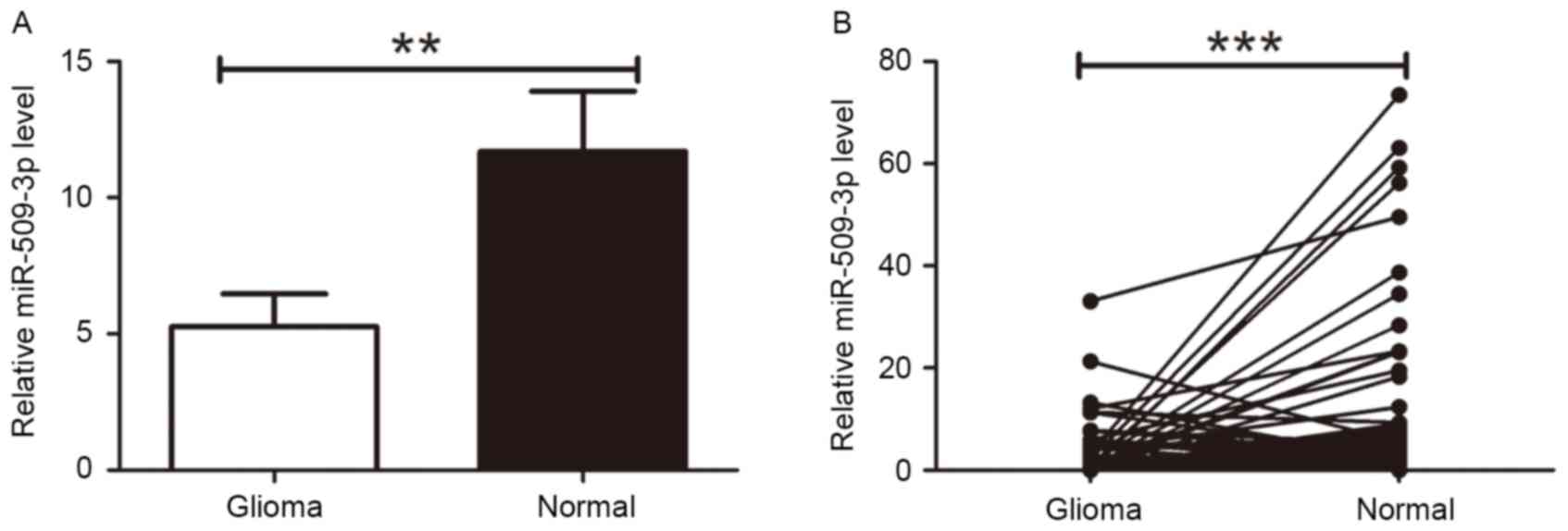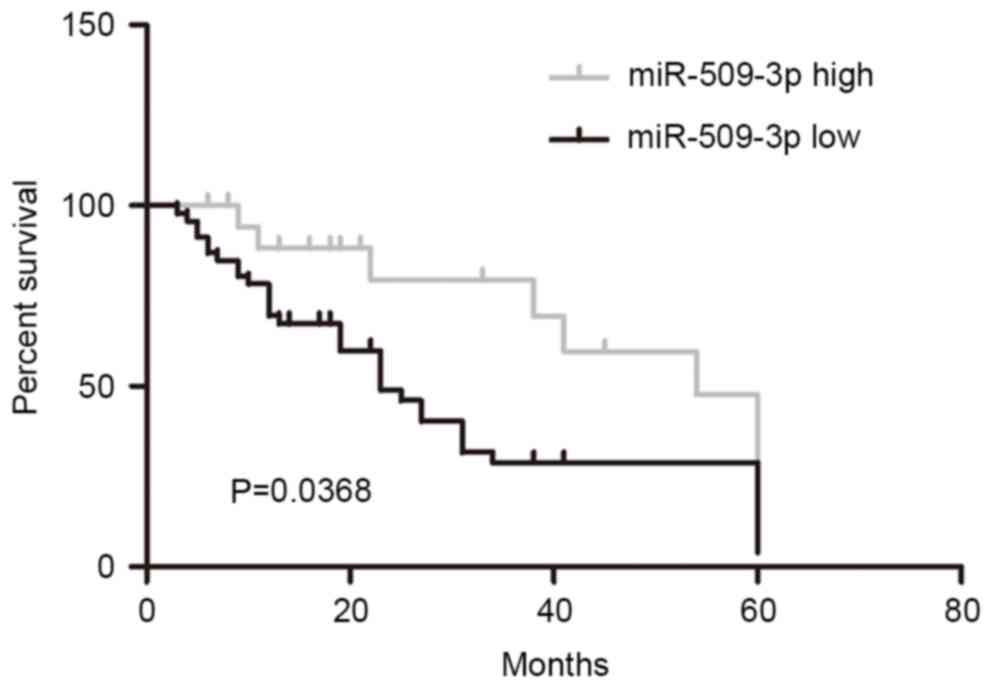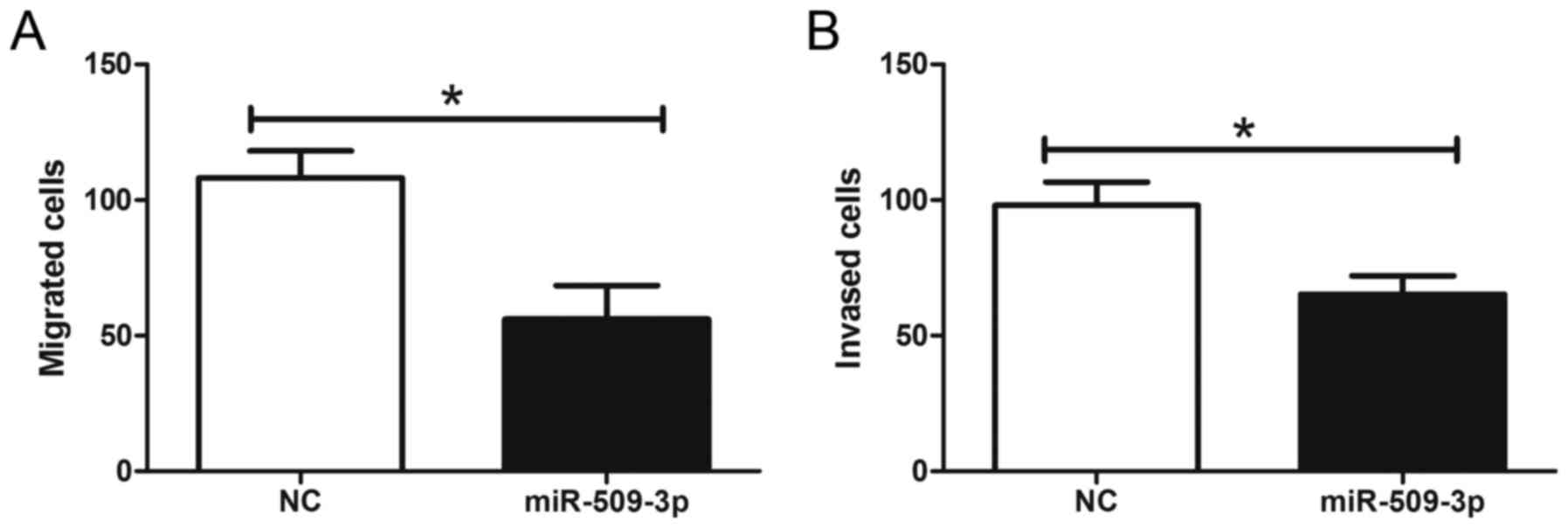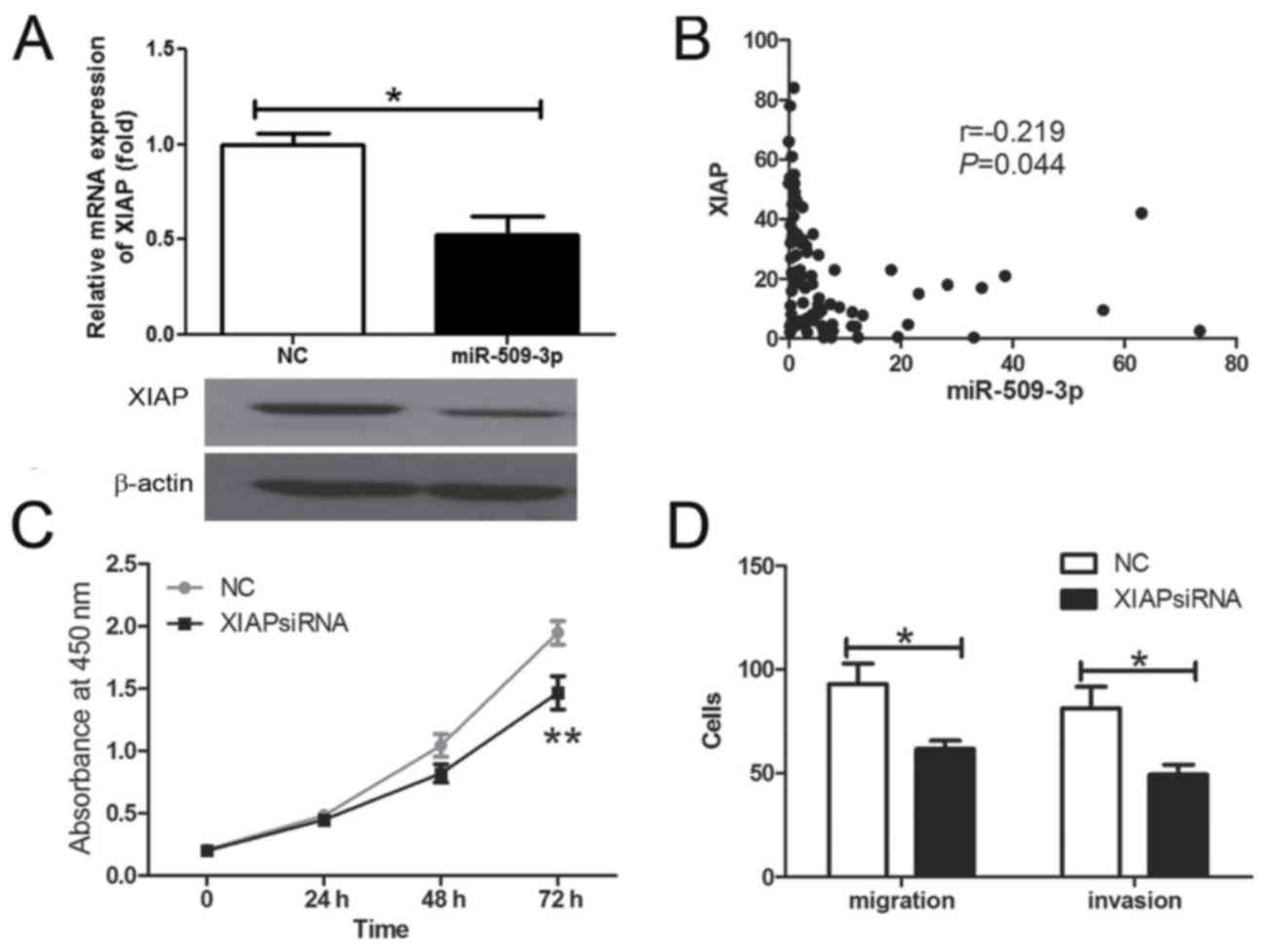MicroRNA‑509‑3p inhibits cell proliferation and invasion via downregulation of X‑linked inhibitor of apoptosis in glioma
- Authors:
- Published online on: November 10, 2017 https://doi.org/10.3892/ol.2017.7390
- Pages: 1307-1312
Abstract
Introduction
Malignant glioma, the most frequent type of malignant brain tumor in adults, is associated with an extremely poor prognosis due to the rapid growth and highly invasive nature that favor its infiltration into surrounding normal brain parenchyma and facilitates recurrence following therapy (1,2). Glioma is a major therapeutic challenge due to numerous factors, including the tendency to adapt resistance against antiangiogenic agents, and intratumoural cellular heterogeneity that varies over the course of the disease and its treatment (3). To improve the poor prognosis for patients with glioma, it is important to understand the molecular mechanisms underlying and supporting tumor cell survival and invasion.
Mounting evidence has demonstrated that microRNAs (miRs), small non-coding RNAs of ~18–24 nucleotides in length, regulate various biological processes, including cancer progression and metastasis, by mediating the posttranscriptional silencing of specific target mRNAs. A total of >1,500 miRs have been identified in the human genome, which collectively control an estimated 30% of human genes (4). Each miRNA appears to modulate tens to hundreds of target genes to coordinate cellular signaling pathways. It has been demonstrated that miRs may regulate the proliferation and apoptosis of tumor cells and act as oncogenes or tumor suppressor genes. Previously, it was reported that miR-509-3p functions as a tumor suppressor, potentially serving prominent roles in the development of various types of cancer, including renal cell carcinoma, breast cancer, acute lymphoblastic leukemia, lung cancer and hepatoma (5–9). However, although there is a large body of research regarding the molecular mechanisms of malignant glioma, the functions of miR-509-3p and its target genes in regulating malignant glioma progression require further investigation.
Materials and methods
Cell culture and transfection
The U251 human glioma cell line purchased from the Cell Bank of Type Culture Collection of Chinese Academy of Sciences (Shanghai, China) was maintained in RPMI-1640 medium supplemented with 10% fetal bovine serum (FBS; both Gibco; Thermo Fisher Scientific, Inc., Waltham, MA, USA) at 37°C in 5% CO2. A miR-509-3p mimic and a mimic control were purchased from Shanghai GenePharma Co., Ltd. (Shanghai, China). Human X-linked inhibitor of apoptosis (XIAP) short interfering (si) RNA and scramble siRNA were purchased from Shanghai GenePharma Co., Ltd. The oligonucleotide sequences were as follows: miR-509-3p mimic forward, 5′-UGAUUGGUACGUCUGUGGGUAGTT-3′ and reverse, 5′-CUACCCACAGACGUACCAAUCATT-3′; mimic control forward, 5′-UUGUCCGAACGUGUCACGUTT-3′ and reverse, 5′-ACGUGACACGUUCGGAGAATT-3′; si-XIAP forward, 5′-GUGGUAGUCCUGUUUCAGCTT-3′ and reverse, 5′-GCUGAAACAGGACUACCACTT-3′; scramble siRNA forward, 5′-UUCUCCGAACGUGUCACGUTT-3′ and reverse, 5′-ACGUGACACGUUCGGAGAATT-3′. The U251 cells were transfected using Lipofectamine 3000 (Invitrogen; Thermo Fisher Scientific, Inc.), according to the manufacturer's protocol. At 48 h, the cells were harvested for further analysis.
Tissue samples and patient data
Tumor and non-tumor tissue samples from 120 patients (69 males and 51 females) with glioma who underwent surgical resection were obtained from the Second Affiliated Hospital of Xinjiang Medical University (Ürümqi, China) between February 2010 and December 2014. The mean age was 50.13 years (range, 31–67 years). The tissue samples were immediately aliquoted into separate tubes, frozen on dry ice and stored at −80°C until analysis. Follow-up data were obtained from a review of the patients' medical records. None of the patients had received radiotherapy or chemotherapy prior to surgical resection. The present study was approved by the Ethics Committee of Xinjiang Medical University. The study was performed in accordance with the regulations of the Institutional Review Board of Xinjiang Medical University. Written informed consent was obtained prior to surgery from all enrolled patients.
RNA extraction and reverse transcription-quantitative polymerase chain reaction (RT-qPCR)
Total RNA, including miRNA, of cell lines and tissue samples was isolated using TRIzol® reagent (Invitrogen; Thermo Fisher Scientific, Inc., USA), according to the manufacturer's protocol. The first-strand cDNA was synthesized from 1 µg of total RNA using PrimeScript RT reagent kit with gDNA Eraser (Takara Bio, Inc., Otsu, Japan). Quantitative PCR of XIAP and GAPDH was performed using SYBR Premix Ex Taq II (Takara, Bio, Inc.). The reaction protocol involved heating for 10 sec at 95°C, followed by 40 cycles of amplification (5 sec at 95°C and 30 sec at 60°C). Subsequent to reverse transcribing with TaqMan™ MicroRNA Reverse Transcription Kit (Applied Biosystems; Thermo Fisher Scientific, Inc.), a TaqMan microRNA assay kit (Applied Biosystems; Thermo Fisher Scientific, Inc.) was used to determine the expression level of miR-509-3p and U6. U6 small nuclear RNA was used as an internal control. The reaction protocol involved heating for 20 sec at 95°C, followed by 40 cycles of amplification (3 sec at 95°C and 30 sec at 60°C). The relative expression level (as fold change) of the target gene (2−∆∆Cq) was normalized to the endogenous U6 or GAPDH reference (∆Cq) (10). Primer sequences were as follows: miR-509-3p forward, 5′-TGATTGGTACGTCTGTGGGTAG-3′ with a universal reverse primer from the TaqMan kit; U6 forward, 5′-CTCGCTTCGGCAGCACA-3′ and reverse, 5′-ACGCTTCACGAATTTGCGT-3′; XIAP forward, 5′-ACCGTGCGGTGCTTTAGTT-3′ and reverse, 5′-TGCGTGGCACTATTTTCAAGATA-3′; GAPDH forward, 5′-AGAAGGCTGGGGCTCATTTG-3′ and reverse, 5′-AGGGGCCATCCACAGTCTTC-3′. Three independent experiments were performed to analyze the relative gene expression and each sample was analyzed in triplicate.
Cell proliferation and colony formation assays
A Cell Counting Kit-8 (CCK-8; Beyotime Institute of Biotechnology, Shanghai, China) was used according to the manufacturer's protocol. Cells were seeded into 96-well plates at a density of 3,000 cells in 100 µl medium per well, in quadruplicate. Absorbance at 450 nm was evaluated 1 h after the addition of 10 µl CCK-8 reagent per well, to determine the number of viable cells. Cell viability was evaluated as the percentage of viable cells relative to vehicle-treated cells. For the colony formation assay, 1,000 cells were seeded in a six-well plate. Following a 14-day incubation, surviving colonies were counted using 0.1% crystal violet staining for 20 min at room temperature. Triplicate independent experiments were performed.
Apoptosis assay
A total of 5×105 cells were harvested and stained with Annexin-V (allophycocyanin) and propidium iodide (1 mg/ml) for 15 min at 4°C in the dark. Data were acquired with a fluorescence-activated cell sorting Canto II flow cytometer (BD Biosciences, San Jose, USA) and analyzed with the Diva 6.1.3 software (BD Biosciences). Triplicate independent experiments were performed.
Migration and invasion assay
A total of 2×104 cells were seeded into the upper chambers of Transwell chambers (Corning Incorporated, Corning, NY, USA) in 200 µl RPMI-1640 medium; 500 µl RPMI-1640 supplemented with 10% FBS was added into the lower wells as the chemo-attractant. For the invasion assay, the chambers were also coated with Matrigel (BD Biosciences). At 24 h, the filters were stained with crystal violet. Cell migration and invasion were assessed by counting the number of cells that had penetrated through the filter under the light microscope (Leica Microsystems GmbH, Wetzlar, Germany) at magnification, ×200 in 10 random fields. The experiments were repeated at least three times.
Western blot
Cells were lysed with RIPA lysis buffer (Beyotime Institute of Biotechnology, Shanghai, China). The protein concentration was determined by Enhanced BCA Protein Assay Kit (Beyotime Institute of Biotechnology, Shanghai, China). The protein samples were denatured by boiling for 10 min. Protein samples (20 µg per lane) were loaded onto SDS-PAGE (10%) gel for electrophoresis and transferred to a PVDF membrane (Millipore, MD, USA). The membrane was incubated with a primary rabbit monoclonal antibody against human XIAP (1:1,000; Cell Signaling Technology, Massachusetts, USA) or a rabbit monoclonal antibody against human β-actin (1:1,000; Cell Signaling Technology, Massachusetts, USA) at 4°C overnight and then incubated for 1 h with a goat anti-rabbit (1:5,000; Cell Signaling Technology, Massachusetts, USA) secondary antibody. Signals were detected by enhanced chemiluminescence detection reagents (Pierce, IL, USA). Three independent experiments were performed for each analysis and the gels have been run under the same experimental conditions.
Statistical analysis
All statistical analyses were performed using SPSS version 17.0 (SPSS, Inc., Chicago, IL, USA) software. Data are presented as the mean ± standard deviation and were analyzed using the Student's t-test. The paired t-test was used for paired samples. The Kaplan–Meier method in combination with log-rank test was performed to evaluate the overall survival between subgroups. Pearson's test was adapted to determine the correlation between miR-509-3p and XIAP expression. P<0.05 was considered to indicate a statistically significant difference.
Results
miR-509-3p was frequently downregulated in glioma
To determine the expression level of miR-509-3p in glioma tissues, RT-qPCR was performed for all 120 tumor and 66 non-tumor tissue samples. The RT-qPCR analysis revealed that miR-509-3p expression in tumor tissue was downregulated compared with non-cancer tissue (P=0.0061; Fig. 1A). Furthermore, 66 paired tumor tissues and corresponding neighboring non-cancer tissues were compared, which further demonstrated the downregulation of miR-509-3p in tumor tissue (P=0.0004; Fig. 1B). These results suggested that miR-509-3p may act as a tumor suppressor in human glioma.
miR-509-3p expression is associated with disease progression
In order to investigate the prognostic role of miR-509-3p downregulation in malignant glioma, patients were divided into high and low-miR-509-3p groups according to the median value of miR-509-3p expression (median value of the 120 giloma specimens, 0.88) from all 120 cases. Kaplan-Meier analysis revealed that the downregulation of miR-509-3p was significantly associated with a poorer outcome for patients with glioma (Fig. 2; P=0.0368). These results suggested that miR-509-3p may serve a role in glioma progression.
miR-509-3p inhibited cell proliferation by inducing cell apoptosis in vitro
To further assess the tumor suppressive role of miR-509-3p in glioma cells, an miR-509-3p mimic was used. The CCK8 results indicated that miR-509-3p upregulation may inhibit cell proliferation in U251 cells compared with a mimic control (Fig. 3A; P=0.006). Furthermore, it was revealed that the upregulation of miR-509-3p may promote apoptosis compared with the control (Fig. 3B and C; P=0.0252). These results suggested that miR-509-3p may inhibit cell proliferation by promoting apoptosis in glioma cells.
Upregulation of miR-509-3p suppressed cell motility and invasiveness in vitro
To further elucidate the effect of miR-509-3p on the metastatic potential of human glioma, glioma cells were transfected with an miR-509-3p mimic and then analyzed for their metastatic potential by Transwell assays. The results revealed that miR-509-3p overexpression significantly reduced cell migration and invasion compared with the transfection control (Fig. 4; Pmigration=0.0311, Pinvasion=0.0422). These results demonstrated that the upregulation of miR-509-3p may inhibit the metastatic potential of human glioma.
XIAP is a functional target of miR-509-3p in human glioma
The present study further investigated whether XIAP may have been regulated by mir-509-3p in human glioma cells. The results demonstrated that the XIAP mRNA and protein expression were inhibited by the overexpression of miR-509-3p (Fig. 5A; P=0.0157). Further analysis revealed that the expression of miR-509-3p was inversely associated with XIAP mRNA expression level in human glioma tissue samples (Fig. 5B; P=0.044). The present study demonstrated that XIAP silencing may inhibit cell proliferation (Fig. 5C; P=0.023), migration and invasiveness (Fig. 5D; Pmigration=0.0441, Pinvasion=0.0497) in vitro. These results revealed that XIAP has the opposite effect on cell proliferation and migration in comparison with miR-509-3p, indicating that it may be a functional target for miR-509-3p in human glioma cells.
Discussion
An increasing number of miRNAs have been implicated in numerous critical biological processes, including tumor development and progression. For example, it was reported that miR-515-5p overexpression inhibited cell migration by downregulating microtubule affinity regulating kinase 4 mRNA expression levels in breast and lung cancer (11). Kouhkan et al (12) demonstrated that miR-129-1, a potential tumor suppressor, induced cell cycle arrest by negatively regulating insulin like growth factor 2 mRNA binding protein 3 and mitogen-activated protein kinase 1 in glioblastoma multiforme cells. Tan et al (13) demonstrated that miR-1229 overexpression promoted cell proliferation and tumorigenicity and activated Wnt/β-catenin signaling in breast cancer. Edmonds et al (14) revealed that miR-31 expression initiated lung tumorigenesis and promoted mutant KRAS-driven lung cancer. Raffel and Trumpp (15) demonstrated that miR-126, as a regulator of phosphatidylinositol 3-kinase-protein kinase B-mechanistic target of rapamycin and cyclin-dependent kinase (CDK) 3 signaling, was driving leukemic stem cell self-renewal and chemotherapy resistance. In addition, >50% of human microRNA genes are located in cancer-associated genomic regions or fragile sites (16).
The present study revealed that miR-509-3p was significantly downregulated in malignant glioma tissues samples compared with in normal tissues samples. Furthermore, the results demonstrated that the overexpression of miR-509-3p inhibited the proliferation and motility of malignant glioma cells. These data are in accord with the in vitro data reported by Yoon et al (6), in which the overexpression of miR-509-3p induced G1 cell-cycle arrest, and inhibited colony formation and migration via the downregulation of CDK2, ras-related C3 botulinum toxin substrate 1 and phosphatidylinositol-4-phosphate 3-kinase catalytic subunit type 2 α. The present study also demonstrated that relatively low levels of miR-509-3p expression were significantly associated with poor outcomes in glioma. These results suggest that glioma tumorigenesis may be associated with the decreased expression level of miR-509-3p.
XIAP is the most potent member in the family of inhibitors of apoptosis; it is able to inhibit caspase-3 and −7 by binding them to its XIAP baculovirus IAP repeat (BIR)2 domain, and caspase-9 by binding it to its BIR3 domain (17). It has been reported that XIAP expression is elevated in numerous types of cancer (18–21). Thus, the downregulation of XIAP is recognized as a potential anticancer approach (22–24). In epithelial ovarian cancer, miR-509-3p, a downregulated miRNA, can directly target the XIAP via its 3′-untranslated region (UTR) (25).
In general, miRs function by binding to the 3′-UTRs of target genes. The present study aimed to investigate whether miR-509-3p targeted XIAP in glioma cells. The present study revealed that miR-509-3P negatively regulated XIAP expression, and that miR-509-3p and XIAP were inversely correlated in human glioma tissue samples. The results further confirmed that the downregulation of XIAP may significantly attenuate the proliferation, migration and invasion abilities of glioma cells. However, in the present study, only one glioma cell line was considered; this may represent a study limitation, and further study is required.
In conclusion, the present study demonstrated that miR-509-3p was downregulated in glioma tissue samples compared with normal brain tissue, and that low expression levels of miR-509-3p were associated with poor glioma outcomes. XIAP was previously identified as a potential target for miR-509-3p, and miR-509-3p was demonstrated to function as a negative regulator of XIAP in the present study. Collectively, miR-509-3p, considered as a tumor-suppressor gene, inhibits cell proliferation and invasion by targeting XIAP in glioma, which may provide a novel insight into tumorigenesis and the basis for the development of miRNA-targeting therapies against glioma.
Acknowledgements
The present study was supported by grants from Autonomous Region Natural Science Foundation of Xinjiang (grant no. 2017D01C247).
References
|
Ostrom QT, Gittleman H, Farah P, Ondracek A, Chen Y, Wolinsky Y, Stroup NE, Kruchko C and Barnholtz-Sloan JS: CBTRUS statistical report: Primary brain and central nervous system tumors diagnosed in the United States in 2006–2010. Neuro Oncol. 15 Suppl 2:S1–S56. 2013. View Article : Google Scholar | |
|
Wen PY and Kesari S: Malignant gliomas in adults. N Engl J Med. 359:1–507. 2008. View Article : Google Scholar : PubMed/NCBI | |
|
Johnson BE, Mazor T, Hong C, Barnes M, Aihara K, McLean CY, Fouse SD, Yamamoto S, Ueda H, Tatsuno K, et al: Mutational analysis reveals the origin and therapy-driven evolution of recurrent glioma. Science. 343:189–193. 2014. View Article : Google Scholar : PubMed/NCBI | |
|
Griffiths-Jones S, Grocock RJ, van Dongen S, Bateman A and Enright AJ: miRBase: microRNA sequences, targets and gene nomenclature. Nucleic Acids Res. 34(Database Issue): D140–D144. 2006. View Article : Google Scholar : PubMed/NCBI | |
|
Tan YS, Kim M, Kingsbury TJ, Civin CI and Cheng WC: Regulation of RAB5C is important for the growth inhibitory effects of MiR-509 in human precursor-B acute lymphoblastic leukemia. PLoS One. 9:e1117772014. View Article : Google Scholar : PubMed/NCBI | |
|
Yoon S, Han E, Choi YC, Kee H, Jeong Y, Yoon J and Baek K: Inhibition of cell proliferation and migration by miR-509-3p that targets CDK2, Rac1, and PIK3C2A. Mol Cells. 37:314–321. 2014. View Article : Google Scholar : PubMed/NCBI | |
|
Su Z, Chen D, Zhang E, Li Y, Yu Z, Shi M, Jiang Z, Ni L, Yang S, Gui Y, et al: MicroRNA-509-3p inhibits cancer cell proliferation and migration by targeting the mitogen-activated protein kinase kinase kinase 8 oncogene in renal cell carcinoma. Mol Med Rep. 12:1535–1543. 2015.PubMed/NCBI | |
|
Xing F, Sharma S, Liu Y, Mo YY, Wu K, Zhang YY, Pochampally R, Martinez LA, Lo HW and Watabe K: miR-509 suppresses brain metastasis of breast cancer cells by modulating RhoC and TNF-α. Oncogene. 34:4890–4900. 2015. View Article : Google Scholar : PubMed/NCBI | |
|
Wang Y, Cui M, Cai X, Sun B, Liu F, Zhang X and Ye L: The oncoprotein HBXIP up-regulates SCG3 through modulating E2F1 and miR-509-3p in hepatoma cells. Cancer Lett. 352:169–178. 2014. View Article : Google Scholar : PubMed/NCBI | |
|
Livak KJ and Schmittgen TD: Analysis of relative gene expression data using real-time quantitative PCR and the 2(-Delta Delta C(T)) method. Methods. 25:402–408. 2001. View Article : Google Scholar : PubMed/NCBI | |
|
Pardo OE, Castellano L, Munro CE, Hu Y, Mauri F, Krell J, Lara R, Pinho FG, Choudhury T, Frampton AE, et al: miR-515-5p controls cancer cell migration through MARK4 regulation. EMBO Rep. 17:570–584. 2016. View Article : Google Scholar : PubMed/NCBI | |
|
Kouhkan F, Mobarra N, Soufi-Zomorrod M, Keramati F, Hosseini Rad SM, Fathi-Roudsari M, Tavakoli R, Hajarizadeh A, Ziaei S, Lahmi Ret, et al: MicroRNA-129-1 acts as tumour suppressor and induces cell cycle arrest of GBM cancer cells through targeting IGF2BP3 and MAPK1. J Med Genet. 53:24–33. 2016. View Article : Google Scholar : PubMed/NCBI | |
|
Tan Z, Zheng H, Liu X, Zhang W, Zhu J, Wu G, Cao L, Song J, Wu S, Song L and Li J: MicroRNA-1229 overexpression promotes cell proliferation and tumorigenicity and activates Wnt/β-catenin signaling in breast cancer. Oncotarget. 7:24076–24087. 2016. View Article : Google Scholar : PubMed/NCBI | |
|
Edmonds MD, Boyd KL, Moyo T, Mitra R, Duszynski R, Arrate MP, Chen X, Zhao Z, Blackwell TS, Andl T and Eischen CM: MicroRNA-31 initiates lung tumorigenesis and promotes mutant KRAS-driven lung cancer. J Clin Invest. 126:349–364. 2016. View Article : Google Scholar : PubMed/NCBI | |
|
Raffel S and Trumpp A: miR-126 Drives Quiescence and Self-Renewal in Leukemic Stem Cells. Cancer Cell. 29:133–135. 2016. View Article : Google Scholar : PubMed/NCBI | |
|
Zhang B, Pan X, Cobb GP and Anderson TA: microRNAs as oncogenes and tumor suppressors. Dev Biol. 302:1–12. 2007. View Article : Google Scholar : PubMed/NCBI | |
|
Vogler M, Walczak H, Stadel D, Haas TL, Genze F, Jovanovic M, Bhanot U, Hasel C, Möller P, Gschwend JE, et al: Small molecule XIAP inhibitors enhance TRAIL-induced apoptosis and antitumor activity in preclinical models of pancreatic carcinoma. Cancer Res. 69:2425–2434. 2009. View Article : Google Scholar : PubMed/NCBI | |
|
Paschall AV, Zimmerman MA, Torres CM, Yang D, Chen MR, Li X, Bieberich E, Bai A, Bielawski J, Bielawska A and Liu K: Ceramide targets xIAP and cIAP1 to sensitize metastatic colon and breast cancer cells to apoptosis induction to suppress tumor progression. BMC Cancer. 14:242014. View Article : Google Scholar : PubMed/NCBI | |
|
Moreno-Martínez D, Nomdedeu M, Lara-Castillo MC, Etxabe A, Pratcorona M, Tesi N, Díaz-Beyá M, Rozman M, Montserrat E, Urbano-Ispizua A, et al: XIAP inhibitors induce differentiation and impair clonogenic capacity of acute myeloid leukemia stem cells. Oncotarget. 5:4337–4346. 2014. View Article : Google Scholar : PubMed/NCBI | |
|
Yabal M, Müller N, Adler H, Knies N, Groß CJ, Damgaard RB, Kanegane H, Ringelhan M, Kaufmann T, Heikenwälder M, et al: XIAP restricts TNF- and RIP3-dependent cell death and inflammasome activation. Cell Rep. 7:1796–1808. 2014. View Article : Google Scholar : PubMed/NCBI | |
|
Ren Y, Han X, Yu K, Sun S, Zhen L, Li Z and Wang S: microRNA-200c downregulates XIAP expression to suppress proliferation and promote apoptosis of triple-negative breast cancer cells. Mol Med Rep. 10:315–321. 2014.PubMed/NCBI | |
|
Li G, Chang H, Zhai YP and Xu W: Targeted silencing of inhibitors of apoptosis proteins with siRNAs: A potential anti-cancer strategy for hepatocellular carcinoma. Asian Pac J Cancer Prev. 14:4943–4952. 2013. View Article : Google Scholar : PubMed/NCBI | |
|
Li XQ, Ke XZ and Wang YM: Treatment of malignant melanoma by downregulation of XIAP and overexpression of TRAIL with a conditionally replicating oncolytic adenovirus. Asian Pac J Cancer Prev. 13:1471–1476. 2012. View Article : Google Scholar : PubMed/NCBI | |
|
Li S, Sun J, Yang J, Zhang L, Wang L, Wang X and Guo Z: XIAP expression is associated with pancreatic carcinoma outcome. Mol Clin Oncol. 1:305–308. 2013. View Article : Google Scholar : PubMed/NCBI | |
|
Chen W, Zeng W, Li X, Xiong W, Zhang M, Huang Y, Zhou L and Jiang S: MicroRNA-509-3p increases the sensitivity of epithelial ovarian cancer cells to cisplatin-induced apoptosis. Pharmacogenomics. 17:187–197. 2016. View Article : Google Scholar : PubMed/NCBI |














